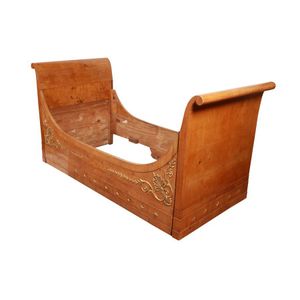19th Century Italian Style Elm Bed from Buonaparte Villa
An elm root lit en bateau bed early 19th century, with gilt wood anthemion, scrolls, Foliage, and frieze of stars to the apron, in the manner of Italian Craftsmanship, height 115 cm, length 229 cm, depth 102 cm. provenance: Purchased in Lucca from the Villa of the family of Paolina Buonaparte Borghese (Napoleon I sister who married Prince Camillo Borghese of Lucca)
You must be a subscriber, and be logged in to view price and dealer details.
Subscribe Now to view actual auction price for this item
When you subscribe, you have the option of setting the currency in which to display prices to $Au, $US, $NZ or Stg.
This item has been sold, and the description, image and price are for reference purposes only.
- Giltwood - Giltwood is used to describe a gold finish on furniture and other decorative wooden items, whereby a thin sheet of gold metal, called gold leaf, is applied to the surface for decorative purposes.
Unlike gilding, where the gold leaf is applied over a coating of gesso, with giltwood the gold leaf is applied direct to the surface, or over a coat of linseed oil gold leaf adhesive.
Most gold-finished mirrors will be gilded, whereas furniture with gold highlights will have the gold applied through the giltwood method. - Anthemion - An anthemion is a classical decorative design element based on the acanthus flower that consists of a central circular or oval motif surrounded by radiating petals or leaves. It is often used as a border or frieze in architecture, furniture, and other decorative arts. The anthemion is derived from the palmette, a motif that was popular in ancient Greek and Roman art and architecture. It is often associated with the classical world and with Neoclassical style, and it is often used to add a sense of grandeur and formality to a design. The anthemion is also known as a honeysuckle or honeysuckle ornament. It continues to be used in a variety of contexts today, and it is often admired for its elegant and decorative qualities.
- Provenance - A term used to describe the provable history of an antique or work of art, and thus an additional aid to verifying its authenticity. Provenance can have an inflating effect on the price of an item, particularly if the provenance relates to the early settlement of Australia, a famous person, or royalty. Less significant are previous sales of the item through an auction house or dealer.
- Apron - A decorative wooden panel that sits underneath the top surface of a table or chair, and unites the top of the piece with the legs, running at right angles to the underside. On carcase furniture such as a chest or wardrobe, the apron sits below the drawers or doors and attaches to the legs.
On carcase furniture without legs the panel under the drawers or doors sits on the floor and is termed a plinth.
An apron can provide a decorative touch to an otherwise unadorned piece of furniture and at the same time provide structural support and strength. They can be carved or pierced and quite elaborate. - Manner of .... / Style of ..... - A cataloguing term where the item, in the opinion of the cataloguer is a work in the style of the artist, craftsman or designer, possibly of a later period.
- Scrolls - Serpentine-shaped forms, used in cabinet construction and decoration for centuries. The scroll appears in legs, feet, as carving in chair brackets, chair rails and arms. The deeper and more spontaneous the carving is, the earlier the piece is likely to be. The Regency or 'Thomas Hope' scroll, used on pediments and sideboard backs, consists of two scrolls on the horizontal plane, placed back to back in a mirror image, and sometimes decorated with a variety of carved and/or applied ornament, such as shells, foliate and other motifs. Chippendale-style furniture is often distinguished by two corresponding scrolls in the form of a 'C' in the upper splat or where chair legs join the seat rail.
- Frieze - An architectural term denoting the flat, shaped or convex horizontal surface of furniture, between the architrave and the cornice, usually found on a cabinet or bookcase, or on desks and tables where it may include drawers, the area between the top and the legs. In ceramics, the term refers to the banding, of usually a repeating pattern, on the rims of plates and vases.
This item has been included into following indexes:
- beds, material - elm 2
- beds, period or style
- beds, type - sleigh style (lit-en-bateau) 13
Visually similar items

A provincial walnut armchair, English, 17th century
Sold by
in
for
You can display prices in $Au, $US, $NZ or Stg.

A Georgian mahogany candle box, 19th century, with scalloped shaped back. Height 33 cm
Sold by
in
for
You can display prices in $Au, $US, $NZ or Stg.

H.M.A.S. Sydney book stand made from the timber of the famous Australian Royal Navy ship. 16 cm high, 63 cm wide, 25 cm deep
Sold by
in
for
You can display prices in $Au, $US, $NZ or Stg.

Victorian tea caddy, with rosewood veneer, 32.5 cm wide, 18 cm high
Sold by
in
for
You can display prices in $Au, $US, $NZ or Stg.
